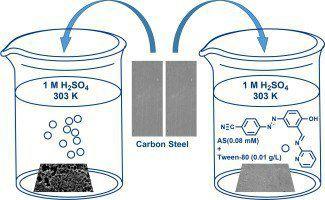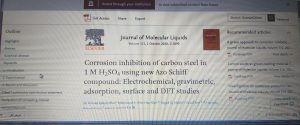A research team from Kerbala University and in cooperation with researchers from inside and outside Iraq has published a scientific paper entitled Corrosion inhibition of carbon steel in 1 M H2SO4 using new Azo Schiff compound: Electrochemical, gravimetric, adsorption, surface and DFT studies.
The team consists of Dr. Hamida Idan Salman, from the Faculty of Education for Pure Sciences, University of Kerbala, and Dr. Asim Alaa Abd Al-Hussein, Assistant Lecturer Ali Ahmed Abdul-Ridha (Education and Higher Education in the Abbasid Holy Shrine, and Assistant Lecturer Mahmoud Abdul Hamza Al-Buhi Allah from the Kerbala Education Directorate, and the teacher Carpets of Qasim Makki from the Al-Safwa University Faculty, in Kerbala, and Dr. Youssef Sirte, from Bozuk University, Yozgat, Turkey
The research is published in the Journal of Molecular Liquids, which has a coefficient of impact, Q1, Impact Factor 4.56, within the Elsevier publishing house.
The research aims at synthesizing new organic compounds to inhibit carbon steel in an acidic medium.
The study deals with the synthesis of the new aromatic Azo-Schiff (AS) compound in two steps, and the evaluation of the new compound as an anti-corrosion inhibitor of carbon steel in 1M H2SO4, and by using the non-ionic surfactant Tween-80 to enhance the solubility of the inhibitor, the electrochemical, gravity, and SEM data confirms AFM believes that AS is an excellent inhibitor of anodic carbon steel corrosion. The adsorption of AS on the surface of carbon steel undergoes isothermal adsorption lancmair.
The study confirms that the new Azo Schiff compound was synthesized and diagnosed using FT-IR, C13 NMR and 1H NMR spectroscopy.
The new compound was evaluated as a corrosion inhibitor for carbon steel in 1 M H2SO4, using electrochemical and gravimetric techniques, and DFT studies were used to explain the nature of the interaction between the AS particles (neutral and proton) and the metal surface. Finally, the shape of both eroded and retarded surfaces were studied by scanning electron microscopy (SEM) and atomic force microscopy (AFM) techniques that confirmed a high inhibition efficiency of AS under optimal conditions, resulting in a significant reduction in the distortion and roughness of the surface observed (reduced Surface roughness from 17.10 nm to 2.15 nm as measured by (AFM),
































































